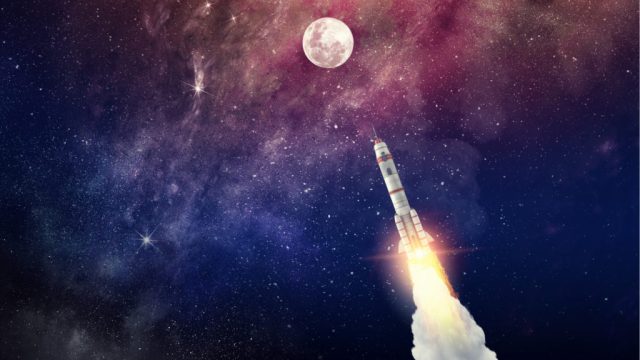What Makes Something A Planet, According To An Astrophysicist?
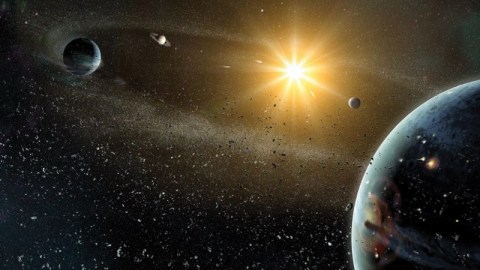
A case for looking beyond the planetary scientist’s (or even the astronomer’s) definition.
Ever since 2006, when the International Astronomical Union (IAU) officially defined the term planet — introducing the term ‘dwarf planet’ to classify Pluto, Eris, Ceres and others — the scientific community has been split in two. Only you have enough mass to pull yourself into a spheroid, orbit the Sun and no other body, and can clear your orbit within Solar System timescales, can you be classified as a planet.
On the one hand are astronomers, mostly planetary astronomers, who largely like the IAU’s definition, but want to extend it to more general cases, including exoplanetary systems. On the other hand are planetary scientists and planetary geologists, who look at intrinsic properties only, and argue that if you can pull yourself into a spheroidal shape, you deserve to be a planet. But to an astrophysicist, both definitions are insufficient. Here’s why.
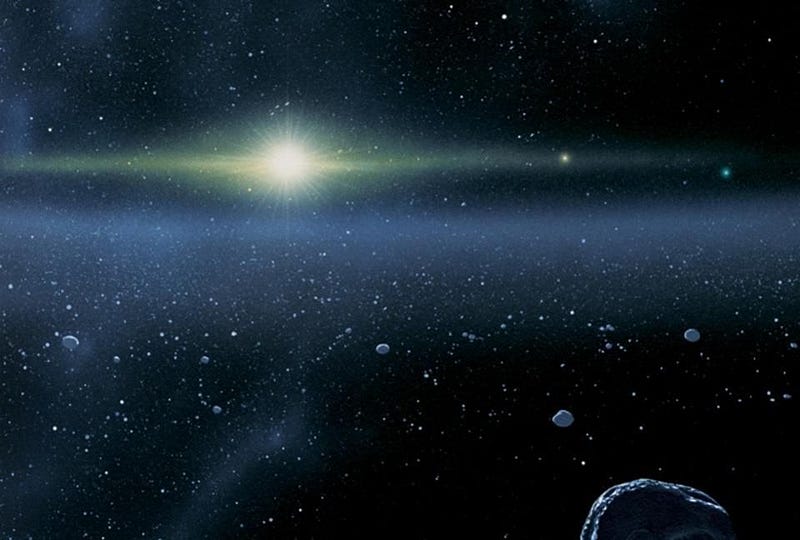
An astrophysicist looks at the objects in the Universe from a different point of view than other types of scientists. We’re not just interested in what the objects we find throughout outer space are like, where they are, and how they behave. Instead, we’re interested in the physics behind their intrinsic and extrinsic properties. We ask questions like the following:
- How did these objects form?
- How is their composition related to their formation history?
- What processes were at play that led to them having the physical and chemical properties they have today?
- And what are the dynamics that drive the evolution of these objects throughout our cosmic history?
When you start asking questions like this, you begin arriving at very general stories that describe planetary formation in general. If you follow these lessons, they’ll lead you in directions that most astronomers and planetary scientists would never have assumed.
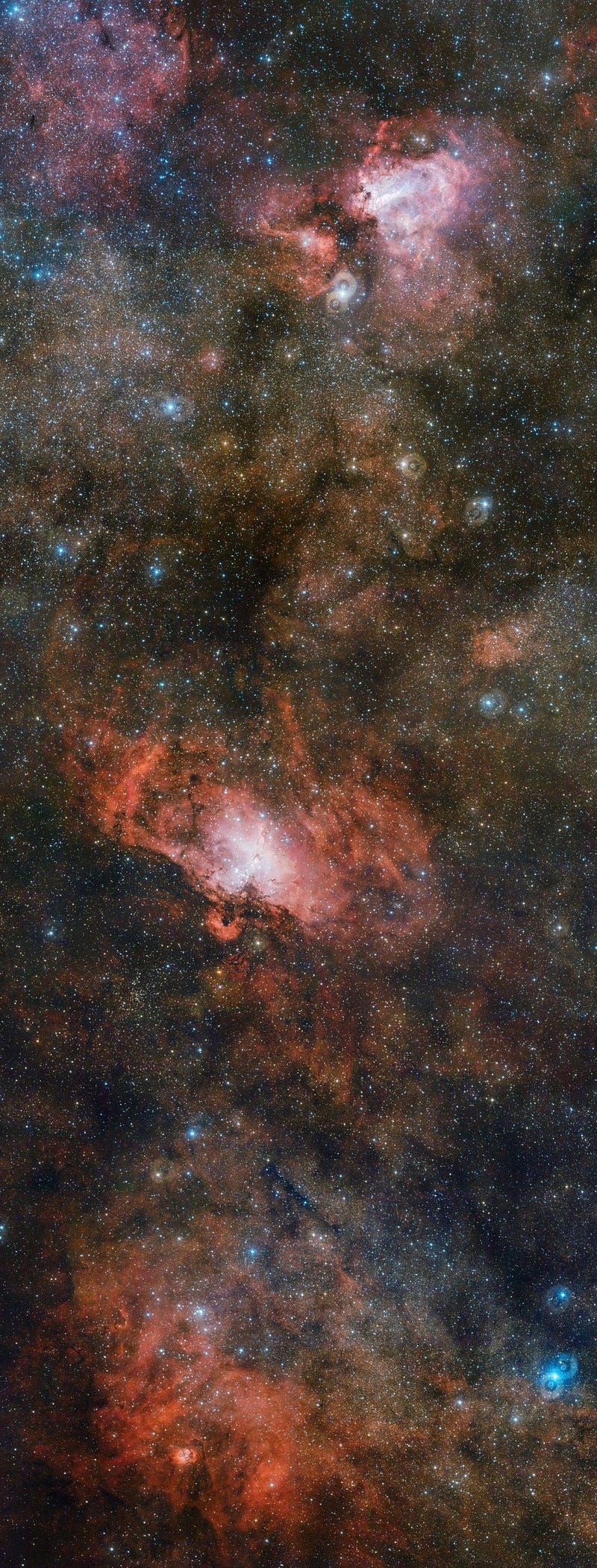
Most stars — and therefore, most solar systems and most planets — form under the same circumstances: in a large, massive, collapsing molecular cloud. When a large enough gas cloud collapses, it fragments into smaller components, where the most overdense regions accrue greater and greater amounts of matter. In our galaxy alone, dozens of these regions are known, giving rise to new stars with new solar systems around them.
These star-forming regions, like the ones found in the Orion Nebula (below), are the locations where new stars and planets form most copiously throughout the Universe. About 50% of all the stars that form will be like our own Solar System, with one central star surrounded by a protoplanetary disk, while the remaining stars will form as part of multi-star systems.

Most of the matter in these newly forming systems will either fall onto the central star(s) in the system or, failing that, will be blown away back into the interstellar medium. However, within these protoplanetary disks, small imperfections begin to grow by gravitationally attracting more and more matter to them.
What ensues, therefore, is a great cosmic race: between the radiation from the stars that evaporates and blows off the nearby matter, and the gravitational growth of these imperfections. The overdense clumps that grow the fastest are the cosmic winners, as gravitation is a runaway force. These lead to the largest planets of all: the gas giants and ice giants of the Universe, with hydrogen and helium envelopes surrounding them.

But, at least according our best understanding, it will take some time to get there. Even with one or more central stars (or proto-stars), there are complicating factors.
First off, the protoplanetary disk is going to undergo segregation of its elements. Just as the heaviest, densest elements sink to the centers of planets (or fall to the bottom of a centrifuge), the heaviest elements will preferentially segregate towards the center, while the lighter elements will be found more abundantly progressively farther out.
As these gravitational perturbations grow, the race intensifies: between planets trying to grow and accrue matter, and the nearby star(s) that evaporate these protoplanetary disks with their high-energy radiation.

This leads to a few separate zones around a newly forming star.
- An interior region where only metals, minerals, and heavy elements and compounds can exist. Organic, aromatic carbon bonds are destroyed by the intense radiation this close to the star.
- A “soot line” that defines the barrier between this interior region and the next one out.
- A temperate region, where these carbon bonds can persist but ices — such as water-ice, methane-ice, and carbon dioxide-ice — are sublimated/evaporated/boiled away.
- A “frost line” that defines the barrier between this temperate region and the next one out.
- A colder region, where ices can form and remain stable.
The location of these lines will change over time, as the star will evolve in temperature and luminosity over its lifetime.
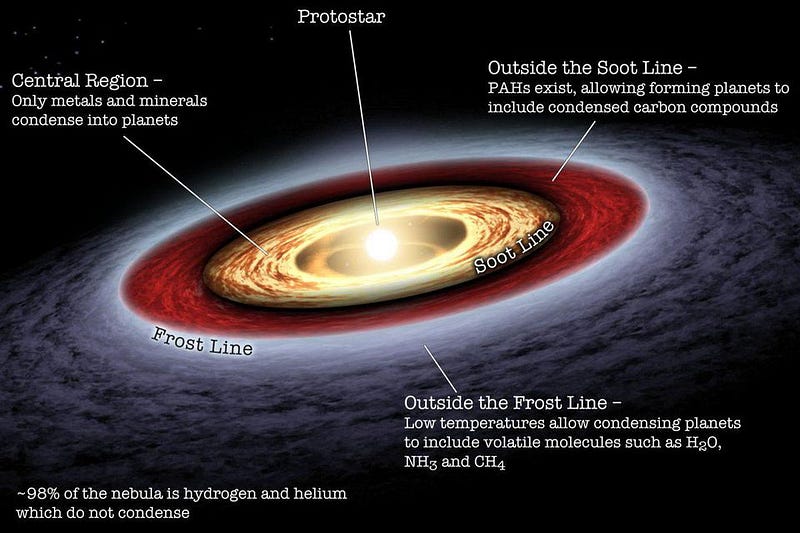
Now, planets and proto-planets don’t simply stay where they first form, but interact with one another over time, leading to a great many interesting possibilities for what can happen. These gravitational interactions will typically lead to planetary migration, where these young planets can move inwards or outwards depending on the dynamics of the Solar System: they will not necessarily remain in the same approximate location to where they formed.
In addition, these planets or proto-planets can collide and merge; this may be the mechanism that created our modern Earth-Moon system.
They can also gravitationally interact, either hurling planets into the Sun or ejecting them from a Solar System entirely.
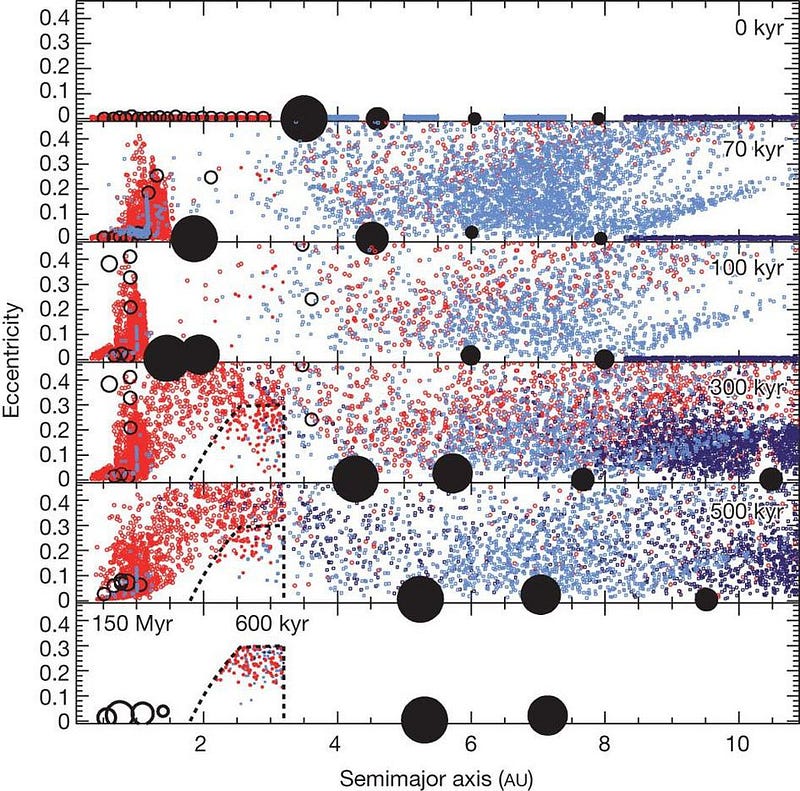
Outside of the frost line, meanwhile, the largest, most massive planets can form. Far enough away from the high temperatures and radiation of their parent star, atoms and molecules of all types can grow into their own miniature solar system. The central planet will accrue most of the mass and matter, enough that they should have a core and mantle like the rocky planets, but enclosed by an enormous gas envelope.
Meanwhile, the matter surrounding them forms a circumplanetary disk, which will break up into rings and moons and moonlets: something we see around all four of the gas/ice giants found in our Solar System at present. These gravitationally dominant bodies — the most massive ones at their location in their solar system — are a product of their own star system’s unique evolutionary history.

Sometimes, though, we find gas giant or ice giant planets nearby their parent stars: interior to the frost line or even the soot line!
How did they get there?
Migration. Gravitational interactions. Via the ejection of other planets or proto-planets. Or even from forming outside of the frost line, and then having the frost line evolve outwards with time.
We think you have to be outside of the frost line to first form a gas/ice giant, but that migration is quite normal. These hot Jupiters (or hot Neptunes) are not at all uncommon, and are some of the easiest planets to find with our current techniques. From the combination of metal-rich material (which forms planetary cores), mantle-like silicates (which can form all throughout a proto-solar system), and ices, gases, and other volatiles (which are more abundant beyond the frost line), we see a general picture begin to emerge.

Interior to the frost line, we’d expect to find a mix of rocky and gas/ice giant planets. Some of them will have formed in situ there, others will have migrated into that region. They may have moons or not.
Right around the frost line, there should be a belt of planetesimals, assuming they haven’t been cleared out by migrating planets, that failed to grow into a full-borne planet. This corresponds to the asteroid belt in our Solar System, and there should be an analogue of this belt in most solar systems.
Exterior to the frost line, there will be additional planets: gas giants, ice giants, and in many systems (but not our own), terrestrial-sized planets. There will continue to be planets, moving outward, until some limit is reached. Beyond that, there will be the icy bodies akin to the ones we find in the Kuiper belt and Oort cloud: interesting in their own right, but composed almost entirely of ices and volatile materials, with comparatively minuscule cores.

This is an accurate descriptor of what we expect to find around any singlet star. Multi-star systems will have certain components removed: tight binaries should have a significant region close to both stars where planetary orbits are unstable. Wide binaries should have interior regions where planet formation is fine, then an intermediate region where no stable planetary orbits are possible, followed by a region well outside of the stellar orbits where planets (or Kuiper belt/Oort cloud objects) are fine again.
But there’s an additional type of planet that we’re missing if we only look at the bodies that remain in orbit around full-blown stars: rogue planets.
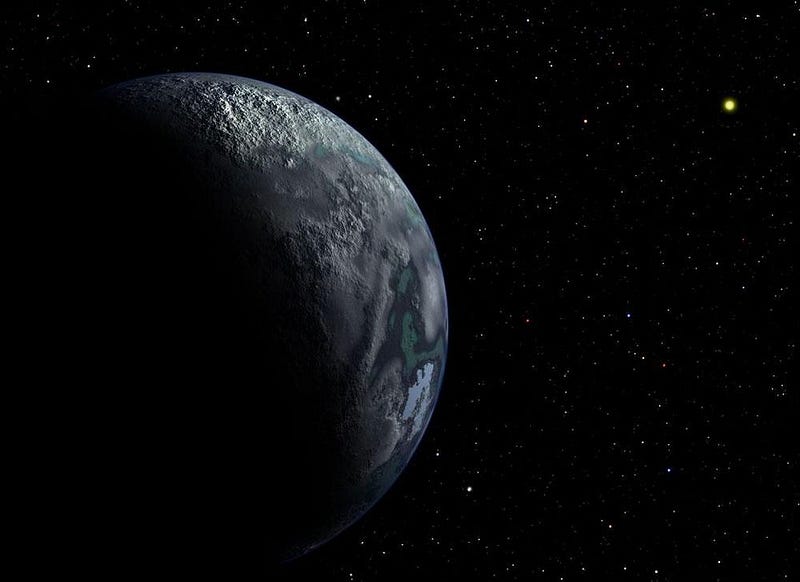
These are planets that either were ejected in the early days of their solar system’s history, or that formed in isolation, without a parent star at all, from the collapse of a molecular cloud. The first type of planet could be a full-grown planet like any of the ones found in nature, or they could be proto-planets that were not yet finished growing up before they were ejected.
The second, on the other hand, could range from small, rocky/icy worlds all the way up to gas giants or even brown dwarfs (failed stars), complete with their own pseudo-planetary systems. As our telescopic power and the surveys we conduct with these instruments continue to increase, we fully expect to find large populations of all of these bodies: around stars, in interstellar space, and all throughout the galaxy and Universe.
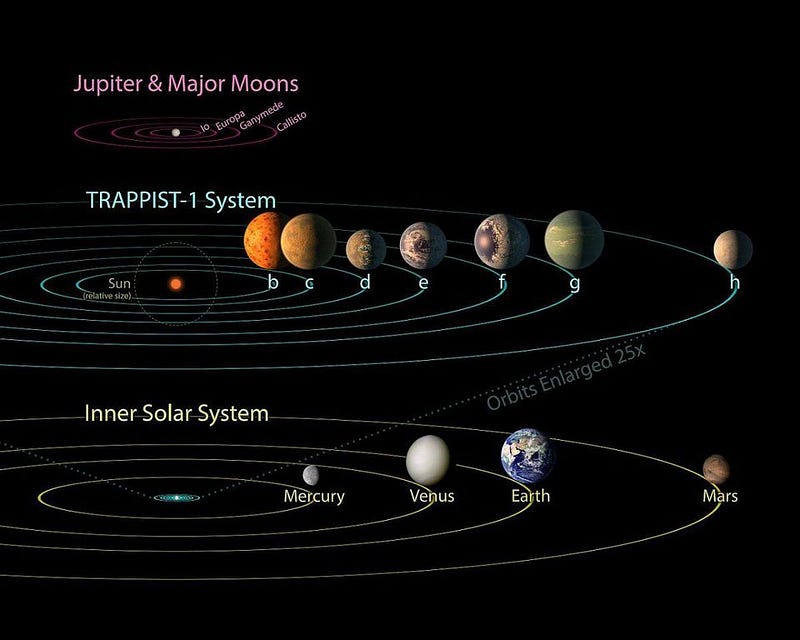
From an astrophysicist’s perspective, the types of objects we find throughout the Universe are inextricably linked to their composition and formation, and that’s the only sensible way to classify them. Non-stellar objects that are massive beyond a certain threshold are like animals: the broadest category that we can classify them into.
Objects that win their gravitational race against radiation and that don’t become the failed planets of the asteroid belt, Kuiper belt, or Oort cloud are more like a narrow category like mammals: where they have certain properties and histories that link them together, independent of the other classes. Similarly, asteroids within a solar system are all similar, as are Kuiper belt objects and Oort cloud objects. They are like birds, reptiles, and amphibians: all animals, but of a different class than mammals.
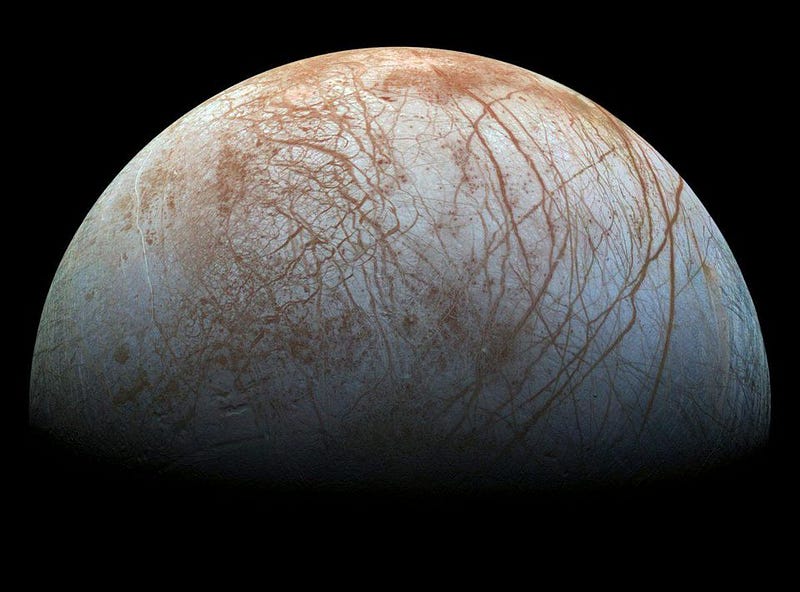
A dolphin may look like a fish, but it’s really a mammal. Similarly, the composition of an object is not the only factor in classifying it: its evolutionary history is inextricably related to its properties. Scientists will likely continue to argue over how to best classify all of these worlds, but it’s not just astronomers and planetary scientists who have a stake in this. In the quest to make organizational sense of the Universe, we have to confront it with the full suite of our knowledge.
Although many will disagree, moons, asteroids, Kuiper belt and Oort cloud objects are fascinating objects just as worthy of study as modern-day planets are. They may even be better candidates for life than many of the true planets are. But each object’s properties are inextricably related to the entirety of its formation history. When we try to classify the full suite of what we’re finding, we must not be misled by appearances alone.
Ethan Siegel is the author of Beyond the Galaxy and Treknology. You can pre-order his third book, currently in development: the Encyclopaedia Cosmologica.





